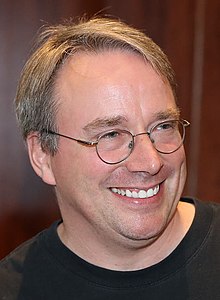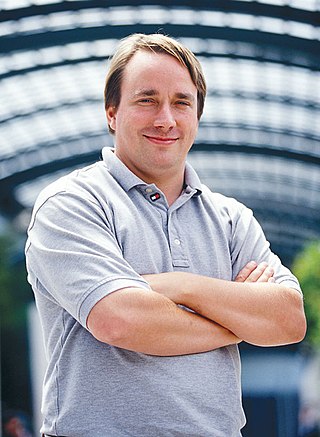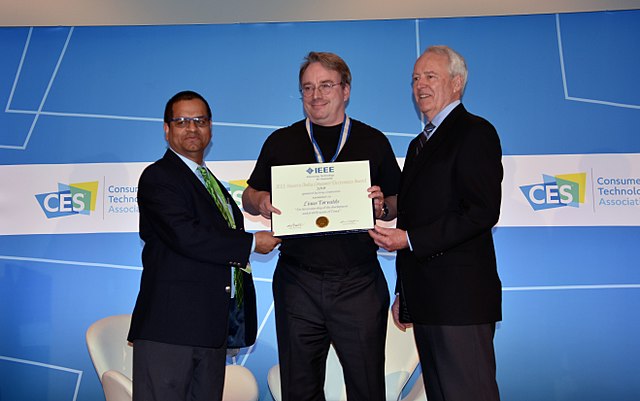Loading AI tools
Creator and lead developer of the Linux kernel (born 1969) From Wikipedia, the free encyclopedia
Linus Benedict Torvalds (/ˈliːnəs ˈtɔːrvɔːldz/ LEE-nəs TOR-vawldz,[2] Finland Swedish: [ˈliːnʉs ˈtuːrvɑlds] ; born 28 December 1969) is a Finnish and American software engineer who is the creator and lead developer of the Linux kernel. He also created the distributed version control system Git.
Linus Torvalds | |
|---|---|
 Torvalds in 2018 | |
| Born | Linus Benedict Torvalds 28 December 1969 Helsinki, Finland |
| Nationality |
|
| Alma mater | University of Helsinki (M.S.)[1] |
| Occupation | Software engineer |
| Employer | Linux Foundation |
| Known for | Linux, Git |
| Spouse | Tove Torvalds |
| Children | 3 |
| Parent(s) | Nils Torvalds (father) Anna "Mikke" Torvalds (née Törnqvist, mother) |
| Relatives | Sara Torvalds (sister) Leo Törnqvist (grandfather) Ole Torvalds (grandfather) |
He was honored, along with Shinya Yamanaka, with the 2012 Millennium Technology Prize by the Technology Academy Finland "in recognition of his creation of a new open source operating system for computers leading to the widely used Linux kernel".[3] He is also the recipient of the 2014 IEEE Computer Society Computer Pioneer Award[4] and the 2018 IEEE Masaru Ibuka Consumer Electronics Award.[5]
Torvalds was born in Helsinki, Finland, on 28 December 1969, the son of journalists Anna and Nils Torvalds,[6] the grandson of statistician Leo Törnqvist and of poet Ole Torvalds, and the great-grandson of journalist and soldier Toivo Karanko. His parents were campus radicals at the University of Helsinki in the 1960s. His family belongs to the Swedish-speaking minority in Finland. He was named after Linus Pauling, the Nobel Prize–winning American chemist, although in the book Rebel Code: Linux and the Open Source Revolution, he is quoted as saying, "I think I was named equally for Linus the Peanuts cartoon character", noting that this made him "half Nobel Prize–winning chemist and half blanket-carrying cartoon character".[7]
His interest in computers began with a VIC-20[8] at the age of 11 in 1981. He started programming for it in BASIC, then later by directly accessing the 6502 CPU in machine code (he did not utilize assembly language).[9] He then purchased a Sinclair QL, which he modified extensively, especially its operating system. "Because it was so hard to get software for it in Finland", he wrote his own assembler and editor "(in addition to Pac-Man graphics libraries)"[10] for the QL, and a few games.[11][12] He wrote a Pac-Man clone, Cool Man.
Torvalds attended the University of Helsinki from 1988 to 1996,[13] graduating with a master's degree in computer science from the NODES research group.[14] His textbooks while there included Programming the 80386[15] by John H. Crawford and Patrick P. Gelsinger, SYBEX, 1987 ISBN 0895883813, and The Design of the UNIX Operating System[16] by Maurice J. Bach, Prentice-Hall, 1986 ISBN 0-13-201799-7.[17]
He bought computer science professor Andrew Tanenbaum's book Operating Systems: Design and Implementation, in which Tanenbaum describes MINIX, an educational stripped-down version of Unix. In 1990, Torvalds resumed his university studies, and was exposed to Unix for the first time in the form of a DEC MicroVAX running ULTRIX.[18] His MSc thesis was titled Linux: A Portable Operating System.[19]
On 5 January 1991[20] he purchased an Intel 80386-based IBM PC clone[21] before receiving his MINIX copy, which in turn enabled him to begin work on Linux.
His academic career was interrupted after his first year of study when he joined the Finnish Navy Nyland Brigade in the summer of 1989, selecting the 11-month officer training program to fulfill the mandatory military service of Finland. He gained the rank of second lieutenant, with the role of an artillery observer.[22]
The first Linux prototypes were publicly released in late 1991.[7][23] Version 1.0 was released on 14 March 1994.[24]
Torvalds first encountered the GNU Project in fall of 1991 when another Swedish-speaking computer science student, Lars Wirzenius, took him to the University of Technology to listen to free software guru Richard Stallman's speech. Torvalds would ultimately switch his original license (which forbade commercial use) to Stallman's GNU General Public License version 2 (GPLv2) for his Linux kernel after complaints of distributors being unable to recoup their costs due to a non-commercial clause.[25]
After a visit to Transmeta in late 1996,[26] Torvalds accepted a position at the company in California, where he worked from February 1997 to June 2003. He then moved to the Open Source Development Labs, which has since merged with the Free Standards Group to become the Linux Foundation, under whose auspices he continues to work. In June 2004, Torvalds and his family moved to Dunthorpe, Oregon[27] to be closer to the OSDL's headquarters in Beaverton.
From 1997 to 1999, he was involved in 86open, helping select the standard binary format for Linux and Unix. In 1999, he was named by the MIT Technology Review TR100 as one of the world's top 100 innovators under age 35.[28]
In 1999, Red Hat and VA Linux, both leading developers of Linux-based software, presented Torvalds with stock options in gratitude for his creation.[29] That year both companies went public and Torvalds's share value briefly shot up to about US$20 million.[30][31]
His personal mascot is a penguin nicknamed Tux,[32] which has been widely adopted by the Linux community as the Linux kernel's mascot.[33]
Although Torvalds believes "open source is the only right way to do software", he also has said that he uses the "best tool for the job", even if that includes proprietary software.[34] He was criticized for his use and alleged advocacy of the proprietary BitKeeper software for version control in the Linux kernel. He subsequently wrote a free-software replacement for it called Git.
In 2008, Torvalds stated that he used the Fedora Linux distribution because it had fairly good support for the PowerPC processor architecture, which he favored at the time.[35] He confirmed this in a 2012 interview.[36] Torvalds abandoned GNOME for a while after the release of GNOME 3.0, saying, "The developers have apparently decided that it's 'too complicated' to actually do real work on your desktop, and have decided to make it really annoying to do". He then switched to Xfce.[37] In 2013, Torvalds resumed using GNOME, noting that "they have extensions now that are still much too hard to find; but with extensions you can make your desktop look almost as good as it used to look two years ago".[38][39]
The Linux Foundation currently sponsors Torvalds so he can work full-time on improving Linux.[40]
Torvalds is known for vocally disagreeing with other developers on the Linux kernel mailing list.[41] Calling himself a "really unpleasant person", he explained, "I'd like to be a nice person and curse less and encourage people to grow rather than telling them they are idiots. I'm sorry—I tried, it's just not in me."[42][43] His attitude, which he considers necessary for making his points clear, has drawn criticism from Intel programmer Sage Sharp and systemd developer Lennart Poettering, among others.[44][failed verification][45]
On Sunday, 16 September 2018, the Linux kernel Code of Conflict was suddenly replaced by a new Code of Conduct based on the Contributor Covenant. Shortly thereafter, in the release notes for Linux 4.19-rc4, Torvalds apologized for his behavior, calling his personal attacks of the past "unprofessional and uncalled for" and announced a period of "time off" to "get some assistance on how to understand people's emotions and respond appropriately". It soon transpired that these events followed The New Yorker approaching Torvalds with a series of questions critical of his conduct.[46][47][48] Following the release of Linux 4.19 on 22 October 2018, Torvalds returned to maintaining the kernel.[49]
In 2024, Russian developers were excluded from the list of Linux kernel maintainers. Torvalds commented: "I'm Finnish. Did you think I'd be supporting Russian aggression?"[50][51]
Initially, Torvalds wanted to call the kernel he developed Freax (a combination of "free", "freak", and the letter X to indicate that it was a Unix-like system), but his friend Ari Lemmke, who administered the FTP server where the kernel was first hosted, named Torvalds' directory linux.[52]
As of 2006, approximately 2% of the Linux kernel was written by Torvalds himself.[31] Despite the thousands who have contributed to it, his percentage is still one of the largest. However, he said in 2012 that his own personal contribution is now mostly merging code written by others, with little programming.[53] He retains the highest authority to decide which new code is incorporated into the standard Linux kernel.[54]
Torvalds holds the Linux trademark[55] and monitors its use,[56] chiefly through the Linux Mark Institute.
On 3 April 2005, Torvalds began development on Git, version control software that later became widely used. On 26 July 2005, he turned over Git's maintenance to Junio Hamano, a major project contributor.
Subsurface is software for logging and planning scuba dives, which Torvalds began developing in late 2011. It is free and open-source software distributed under the terms of the GNU General Public License version 2. Dirk Hohndel became its head maintainer in late 2012.[57][58]

Linus Torvalds is married to Tove Torvalds (née Monni), a six-time Finnish national karate champion, whom he met in late 1993. He was running introductory computer laboratory exercises for students and instructed the course attendees to send him an e-mail as a test, to which Tove responded with an e-mail asking for a date.[7] They were later married and have three daughters, two of whom were born in the United States.[59] The Linux kernel's reboot system call accepts their dates of birth (written in hexadecimal) as magic values.[60][61]
Torvalds has described himself as "completely a-religious—atheist", adding, "I find that people seem to think religion brings morals and appreciation of nature. I actually think it detracts from both. It gives people the excuse to say, 'Oh, nature was just created,' and so the act of creation is seen to be something miraculous. I appreciate the fact that, 'Wow, it's incredible that something like this could have happened in the first place.'" He later added that while in Europe religion is mostly a personal issue, in the United States it has become very politicized. When discussing the issue of church and state separation, he said, "Yeah, it's kind of ironic that in many European countries, there is actually a kind of legal binding between the state and the state religion."[62] In "Linus the Liberator", a story about the March LinuxWorld Conference, Torvalds says: "There are like two golden rules in life. One is 'Do unto others as you would want them to do unto you.' For some reason, people associate this with Christianity. I'm not a Christian. I'm agnostic. The other rule is 'Be proud of what you do.'"[63]
In 2004, Torvalds moved with his family from Silicon Valley to Portland, Oregon.[64]
In 2010, Torvalds became a United States citizen and registered to vote in the United States. As of that year, he was unaffiliated with any U.S. political party, saying, "I have way too much personal pride to want to be associated with any of them, quite frankly."[59]
Linus developed an interest in scuba diving in the early 2000s and has achieved numerous certifications, leading him to create the Subsurface project.[65]

| Year | Award | Notes |
|---|---|---|
| 2019 | Great Immigrants Award | The Carnegie Corporation of New York honored Torvalds.[66] |
| 2018 | IEEE Masaru Ibuka Consumer Electronics Award | IEEE Masaru Ibuka Consumer Electronics Award is conferred by the Institute of Electrical and Electronics Engineers for outstanding contributions to consumer electronics technology has been named in honor of the co-founder and honorary chairman of Sony Corporation, Masaru Ibuka. 2018 Ibuka award was conferred to Linus Torvalds "For his leadership of the development and proliferation of Linux."[5] |
| 2014 | IEEE Computer Pioneer Award | On 23 April 2014, the Institute of Electrical and Electronics Engineers named Torvalds as the 2014 recipient of the IEEE Computer Society's Computer Pioneer Award. The Computer Pioneer Award was established in 1981 by the IEEE Computer Society Board of Governors to recognize and honor the vision of those whose efforts resulted in the creation and continued vitality of the computer industry. The award is presented to outstanding individuals whose main contribution to the concepts and development of the computer field was made at least 15 years earlier.[67] |
| 2012 | Internet Hall of Fame | On 23 April 2012, at Internet Society's Global INET conference in Geneva, Switzerland, Torvalds was one of the inaugural inductees into the Internet Hall of Fame, one of ten in the Innovators category and thirty-three overall inductees.[68] |
| 2012 | Millennium Technology Prize | On 20 April 2012, Torvalds was declared one of two winners of that year's Millennium Technology Prize,[69] along with Shinya Yamanaka.[70] The honor is widely described as technology's equivalent of the Nobel Prize. |
| 2010 | C&C Prize | He was awarded the C&C Prize by the NEC Corporation in 2010 for "contributions to the advancement of the information technology industry, education, research, and the improvement of our lives".[71] |
| 2008 | Hall of Fellows | In 2008, he was inducted into the Hall of Fellows of the Computer History Museum in Mountain View, California, "for the creation of the Linux kernel and the management of open source development of the widely used Linux operating system."[72][73] |
| 2005 | Vollum Award | In August 2005, Torvalds received the Vollum Award from Reed College.[74] |
| 2003 | Linus (Moon) | In 2003, the naming of the asteroid moon Linus was motivated in part by the fact that the discoverer was an enthusiastic Linux user. Although the naming proposal referred to the mythological Linus, son of the muse Calliope and the inventor of melody and rhythm, the name was also meant to honor Linus Torvalds, and Linus van Pelt, a character in the Peanuts comic strip.[75] |
| 2001 | Takeda Award | In 2001, he shared the Takeda Award for Social/Economic Well-Being with Richard Stallman and Ken Sakamura. |
| 2000 | Lovelace Medal | In 2000, he was awarded the Lovelace Medal from the British Computer Society.[76] |
| 1998 | EFF Pioneer Award | In 1998, Torvalds received an EFF Pioneer Award.[77] |
| 1997 | Academic Honors | In 1997, Torvalds received his master's degree (Laudatur Grade) from the Department of Computer Science at the University of Helsinki. Two years later he received honorary doctor status at Stockholm University, and in 2000, he received the same honor from his alma mater.[78]
University of Helsinki has named an auditorium after Torvalds and his computer is on display at the Department of Computer Science. |
| 1996 | 9793 Torvalds (Asteroid) | In 1996, the asteroid 9793 Torvalds was named after him.[79] |
Time magazine has recognized Torvalds multiple times:
InfoWorld presented him with the 2000 Award for Industry Achievement.[82] In 2005, Torvalds appeared as one of "the best managers" in a survey by BusinessWeek.[83] In 2006, Business 2.0 magazine named him one of "10 people who don't matter" because the growth of Linux has shrunk Torvalds's individual impact.[84]
In summer 2004, viewers of YLE (the Finnish Broadcasting Company) placed Torvalds 16th in the network's 100 Greatest Finns. In 2010, as part of a series called The Britannica Guide to the World's Most Influential People, Torvalds was listed among The 100 Most Influential Inventors of All Time (ISBN 9781615300037).[85]
On 11 October 2017, the Linux company SUSE made a song titled "Linus Said".[86]
Prologue: Linus Torvalds; Epilogue: Manuel Castells
Seamless Wikipedia browsing. On steroids.
Every time you click a link to Wikipedia, Wiktionary or Wikiquote in your browser's search results, it will show the modern Wikiwand interface.
Wikiwand extension is a five stars, simple, with minimum permission required to keep your browsing private, safe and transparent.